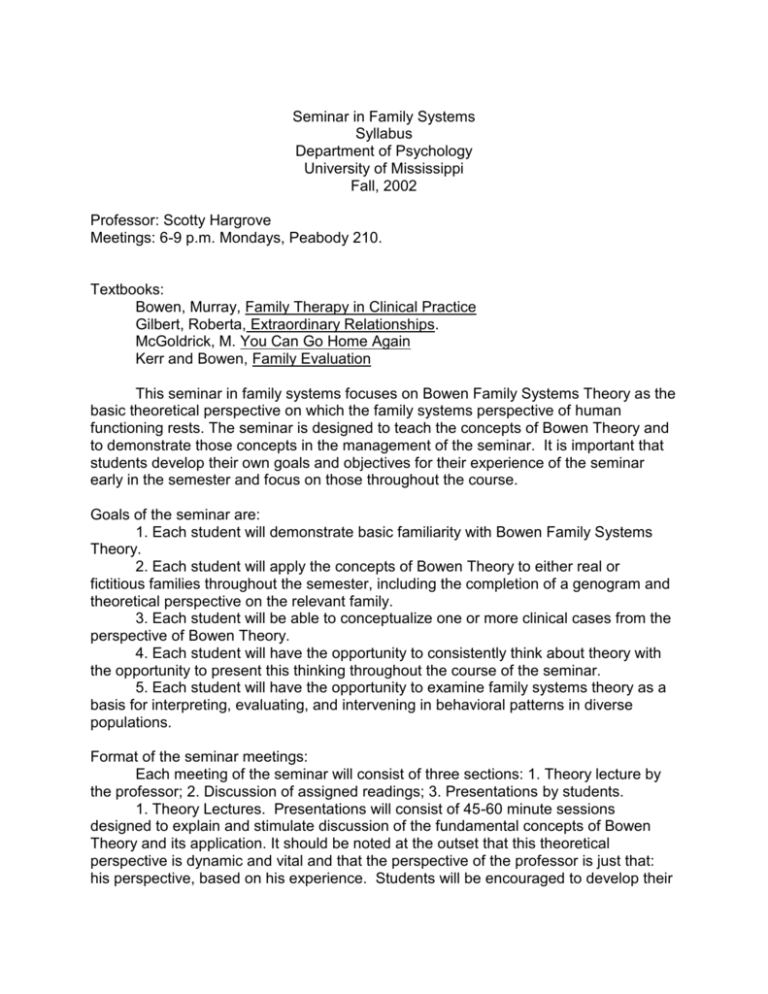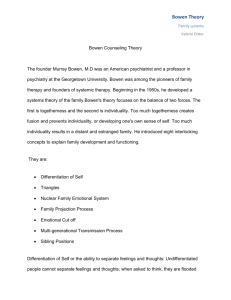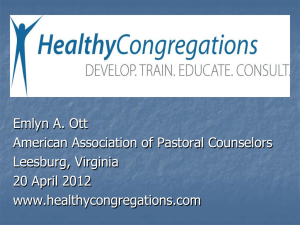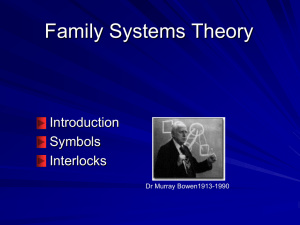Seminar in Family Systems
advertisement

Seminar in Family Systems Syllabus Department of Psychology University of Mississippi Fall, 2002 Professor: Scotty Hargrove Meetings: 6-9 p.m. Mondays, Peabody 210. Textbooks: Bowen, Murray, Family Therapy in Clinical Practice Gilbert, Roberta, Extraordinary Relationships. McGoldrick, M. You Can Go Home Again Kerr and Bowen, Family Evaluation This seminar in family systems focuses on Bowen Family Systems Theory as the basic theoretical perspective on which the family systems perspective of human functioning rests. The seminar is designed to teach the concepts of Bowen Theory and to demonstrate those concepts in the management of the seminar. It is important that students develop their own goals and objectives for their experience of the seminar early in the semester and focus on those throughout the course. Goals of the seminar are: 1. Each student will demonstrate basic familiarity with Bowen Family Systems Theory. 2. Each student will apply the concepts of Bowen Theory to either real or fictitious families throughout the semester, including the completion of a genogram and theoretical perspective on the relevant family. 3. Each student will be able to conceptualize one or more clinical cases from the perspective of Bowen Theory. 4. Each student will have the opportunity to consistently think about theory with the opportunity to present this thinking throughout the course of the seminar. 5. Each student will have the opportunity to examine family systems theory as a basis for interpreting, evaluating, and intervening in behavioral patterns in diverse populations. Format of the seminar meetings: Each meeting of the seminar will consist of three sections: 1. Theory lecture by the professor; 2. Discussion of assigned readings; 3. Presentations by students. 1. Theory Lectures. Presentations will consist of 45-60 minute sessions designed to explain and stimulate discussion of the fundamental concepts of Bowen Theory and its application. It should be noted at the outset that this theoretical perspective is dynamic and vital and that the perspective of the professor is just that: his perspective, based on his experience. Students will be encouraged to develop their own perspectives of the issues that are raised in the seminar. 2. Discussion of readings. Readings are assigned for each presentation. These readings are from the textbooks and will be from selected papers that are appropriate for the topic. The readings are limited to encourage students to think about what is read and to apply those readings to their own experiences. 3. Presentations by students. Each student is asked to make a series of presentations throughout the semester. The topics of these presentations are determined by the students and should be related to Bowen Theory. The most useful presentations are on the student’s family of origin and the work that is stimulated by the course if the students chooses to do this kind of work; a specific application or interpretation of a particular focus of Bowen theory; the application of Bowen theory to a given case in which the student may be active; the application of Bowen theory to a larger system of activity. The presentations will reflect the student’s thinking that is relevant to Bowen theory. The length and frequency of these presentations will depend on the number of students in the class. In all likelihood, each presentation will be from 20-30 minutes, including the discussion that is stimulated by the group. Final Presentations: Each student is asked to develop a more comprehensive final presentation that is based on the thinking that the student has done during the semester. The paper should focus on one or more concepts within Bowen theory. Family of Origin Work. Family of Origin work, which will be explained in the first session, involves understanding one’s own relationships to his or her family. Each of us is involved with our own families in powerful ways and thinking about this will be an important part of the seminar. Many students will want to do family of origin work as a part of the seminar and make it a part of the presentations that are made. If, however, a student is uncomfortable with this type or level of involvement, an alternative assignment will be made. That assignment will involve the application of Bowen theory to a family that is discussed in one or more works of fiction. This can be negotiated with the professor. Students should be reminded that all families have various degrees of pathology in them and that the purpose of the seminar is not to focus on this pathology. It can be used to focus on strengths, patterns of behavior, important choices that are made at certain times in the lives of the families, and other events of theoretical significance. Final Examination. The final examination will cover the fundamental components of the theory and its application. There will be at least one question of application of the theory in either a family system (clinical context) or a larger system. Class Schedule August 19 Introduction to Family Systems. This is an introduction to systems thinking in psychology, differentiating it from individual psychological theory. August 26 Theoretical Considerations. This session focuses on the specific theories of family systems, particularly that of Murray Bowen. The importance of theory in relationship to practice and research is emphasized. The components of Bowen Family Systems Theory are delineated. September 2 Labor Day Holiday September 9 Films September 16 Differentiation of Self. Differentiation of Self is a fundamental concept of Bowen theory. It is defined as one’s ability to remain in contact with one’s family of origin, extended family, and nuclear family, while functioning in as independent a way as possible. While it is believed that differentiation of self may be expressed in different ways in different cultures, little research data supports that assertion. September 23 Triangles. Triangles are the “basic building blocks” of emotional systems. They are formed when dyadic relationships are stressed and relief is sought. Triangles may be traced through multigenerational patterns, nuclear family behavior, and family of origin behavior. September 30 Nuclear Family Emotional System. The nuclear family consists of a household and is an important context in which behavior occurs. This system typically represents parents and children. October 7 Family Projection Process. The family projection process describes the means by which anxiety is dealt with within the nuclear family. There typically are three possible responses to stress among the spouses, including greater conflict and/or distance, one of the partners becoming either physically, mentally, or socially sick, or projection onto a child, resulting in some symptom formation. October 14 Sibling Position. The clinical use of sibling position, based on the work of Walter Toman and Frank Sulloway, is helpful in understanding psychological and physical vulnerability in a family. While the empirical research for the utility of symptom formation in personality research is not particularly strong, it does appear to have clinical utility as a hypothesis generating procedure. A particularly useful form of research is found in the utility of sibling position within and across racially and ethnically diverse groups. October 21 Emotional Cutoff. Removal of one’s self from a family group is one means of coping with the stress. Psychologically, cutoff is the same function as fusion in that the person who cuts off from the family remains equally dependent on the family. The power of cutoff across generations is clear in clinical work. It appears that there are racial and ethnic differences in the power of cutoff, but research in this area is weak and under developed. October 28 Religious/Spiritual Dimensions of Family Systems. The power of religious and spiritual belief is highly influential in explaining behavior patterns from a biopsychosocial perspective. Particularly given racial and ethnically diverse populations, religion and spiritual dimensions must be attended to in competent clinical work. November 4 Symptom Development. The development of symptoms in an individual results from an interaction with the various components of the system over time and across generations. Empirical research has not been helpful in articulating the expression of symptoms but there is evidence of the relational base of symptoms. Again, racial and ethnic diversity has not been addressed. November 11 Applications to Family Therapy November 18 Application to Larger Systems November 25 Fall Holiday December 2 Presentations Plan of Work Date Topic Assignment Activity 8/19 Introduction: Overview, history 1.Kerr, Epilogue (Murray Bowen) 2. Gilbert Orientation to course; genogram development; history of theory 8/26 Intro to Bowen Theory: History; genograms 1. Kerr, Ch. 1-3 2. Papero, Ch 1, 2 3. Gilbert 1. Intro to theory 2. Students present 9/16 Differentiation of Self 1. Kerr, Ch. 4, 5 1. Differentiation lecture; 2. Students present 9/23 Triangles 1. Kerr, Ch 6 1. Triangles Lecture 2. Students present 9/30 Nuclear Family Emotional System 1. Kerr, Ch. 7 1. Lecture 2. Students’ presentations 10/7 Family Projection Process 1. Kerr, Ch 8 1. Lecture 2. Students’ presentations 10/14 Sibling Position 1. Toman (94) 2. Toman (95) 1. Lecture 2. Students’ presentations 10/21 Emotional Cutoff 1. Lecture 2. Students’ presentations 10/28 Religious/Spiritual Dimensions 1. Lecture 2. Students’ presentations 11/4 Symptom Development 9/9 Kerr, Ch. 9 1. Lecture 2. Students’ presentations 11/11 Application to Family Therapy 1. Kerr, Ch 10 2. Bowen, in Guerin 3. Papero, Ch 3 1. Lecture 2. Students’ presentations 11/18 Application to Larger Systems 1. K. Kerr 2. Wiseman 3. Christian 1. Lecture 2. Students’ presentations 11/25 Fall Holiday 12/2 Presentations 12/8 ff Final Examination Final Presentations References Bowen, M. (1976) Theory in the Practice of Psychotherapy. In Philip J. Guerin, Family Therapy: Theory and Practice. New York: Gardner Press. Pp 42-90. Christian, A. A. (1982) The System as Client: Fusion, Triangulation and Emotional Process in Organizational Life. In Ruth Riley Sagar and Kathleen K. Wiseman, Understanding Organizations; Applications of Bowen Family Systems Theory. pp. 47-58. Washington: Georgetown University Family Center. Gilbert, R. (1992) Extraordinary Relationships: A New Way of Thinking About Human Interactions. New York: Wiley., Kerr, K. K. (1982). An Overview of Bowen Theory and Organizations. In Ruth Riley Sagar and Kathleen K. Wiseman, Understanding Organizations; Applications of Bowen Family Systems Theory. pp. 1-8. Washington: Georgetown University Family Center. Kerr, M. E., & Bowen, M. (1988) Family Evaluation: An Approach Based on Bowen Theory. New York: Norton McGoldrick, M., Giordano, J. & Pearce, J. K., Ethnicity and Family Therapy. New York: The Guilford Press Papero, D. V. (1990) Bowen Family Systems Theory. Needham Heights, MA: Allyn and Bacon. Toman, W. (1994). Family constellation theory revisited: Part I. Family Systems. I (2). 101-113 Toman, W. (1995). Family constellation theory revisited: Part 2. Family Systems 2 (1) 316 Wiseman, K. K. (1982) Emotional Process in Organizations. In Ruth Riley Sagar and Kathleen K. Wiseman, Understanding Organizations; Applications of Bowen Family Systems Theory. pp. 33-46. Washington: Georgetown University Family Center.







